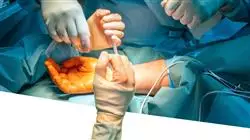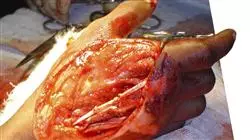University certificate
The world's largest faculty of medicine”
Introduction to the Program
You are in front of the most complete program of clinical knowledge in Hand Surgery. Update yourself with the best specialists in Upper Extremity"

The number of patients requiring surgical interventions in trauma emergencies exceeds 50%, which shows the relevance of this subspecialty in the healthcare field. In addition to this, there is the continuous improvement of technology with the incorporation of Robotics, Artificial Intelligence or 3D, used for the planning of more complex operations.
In this sense, the surgeon is in a moment of transformation and relevance of his performance in order to offer patients effective treatments and to avoid chronic sequelae. A field that requires specialists to be updated in their area. Therefore, in order to promote this update, TECH has designed this 12-month Professional master’s degree in Hand Surgery, developed by an extensive faculty of experts in this field.
It is a program that is distinguished by providing the graduate with the most rigorous information, based on the latest medical evidence through high quality teaching materials. In this way, students will delve through video summaries of each topic, videos in detail, complementary readings and simulations of case studies in the most notorious advances in a dynamic and agile way.
From conservative treatments to address fractures and joint dislocations of the fingers and wrist, the possible sequelae, through the management of tendon, nerve and brachial plexus injuries to the latest technical advances will be treated with the utmost rigor in this program. An academic option that also includes specific modules on Dupuytren's disease, Tumors and Vascular Diseases or delves into the Pediatric Upper Limb.
Undoubtedly, an ideal opportunity to take a quality, flexible program that can be completed comfortably, whenever and wherever you want. The student only needs a digital device with an internet connection to view, at any time of the day, the content hosted on the virtual platform. A university proposal that adapts both to the real needs of healthcare professionals and to their most demanding professional activities.
A university program that addresses ultrasound-assisted surgery, which is becoming more and more widespread"
This Professional master’s degree in Hand Surgery contains the most complete and up-to-date scientific program on the market. The most important features include:
- The development of practical cases presented by experts in Upper Limb Surgery, Orthopedic Surgery and Traumatology
- The graphic, schematic, and practical contents with which they are created, provide scientific and practical information on the disciplines that are essential for professional practice
- Practical exercises where self-assessment can be used to improve learning
- Its special emphasis on innovative methodologies
- Theoretical lessons, questions to the expert, debate forums on controversial topics, and individual reflection assignments
- Content that is accessible from any fixed or portable device with an Internet connection
Delves into specific wrist and hand injuries in certain work and physical activities such as those produced in climbers"
The program’s teaching staff includes professionals from the field who contribute their work experience to this educational program, as well as renowned specialists from leading societies and prestigious universities.
The multimedia content, developed with the latest educational technology, will provide the professional with situated and contextual learning, i.e., a simulated environment that will provide immersive education programmed to learn in real situations.
This program is designed around Problem-Based Learning, whereby the professional must try to solve the different professional practice situations that arise during the academic year This will be done with the help of an innovative system of interactive videos made by renowned experts.
A program designed to fit your professional agenda and your most demanding responsibilities"

Get an update on the great impact of Robotics or 3D printing in Hand Surgery"
Why study at TECH?
TECH is the world’s largest online university. With an impressive catalog of more than 14,000 university programs available in 11 languages, it is positioned as a leader in employability, with a 99% job placement rate. In addition, it relies on an enormous faculty of more than 6,000 professors of the highest international renown.

Study at the world's largest online university and guarantee your professional success. The future starts at TECH”
The world’s best online university according to FORBES
The prestigious Forbes magazine, specialized in business and finance, has highlighted TECH as “the world's best online university” This is what they have recently stated in an article in their digital edition in which they echo the success story of this institution, “thanks to the academic offer it provides, the selection of its teaching staff, and an innovative learning method aimed at educating the professionals of the future”
A revolutionary study method, a cutting-edge faculty and a practical focus: the key to TECH's success.
The most complete study plans on the university scene
TECH offers the most complete study plans on the university scene, with syllabuses that cover fundamental concepts and, at the same time, the main scientific advances in their specific scientific areas. In addition, these programs are continuously being updated to guarantee students the academic vanguard and the most in-demand professional skills. In this way, the university's qualifications provide its graduates with a significant advantage to propel their careers to success.
TECH offers the most comprehensive and intensive study plans on the current university scene.
A world-class teaching staff
TECH's teaching staff is made up of more than 6,000 professors with the highest international recognition. Professors, researchers and top executives of multinational companies, including Isaiah Covington, performance coach of the Boston Celtics; Magda Romanska, principal investigator at Harvard MetaLAB; Ignacio Wistumba, chairman of the department of translational molecular pathology at MD Anderson Cancer Center; and D.W. Pine, creative director of TIME magazine, among others.
Internationally renowned experts, specialized in different branches of Health, Technology, Communication and Business, form part of the TECH faculty.
A unique learning method
TECH is the first university to use Relearning in all its programs. It is the best online learning methodology, accredited with international teaching quality certifications, provided by prestigious educational agencies. In addition, this disruptive educational model is complemented with the “Case Method”, thereby setting up a unique online teaching strategy. Innovative teaching resources are also implemented, including detailed videos, infographics and interactive summaries.
TECH combines Relearning and the Case Method in all its university programs to guarantee excellent theoretical and practical learning, studying whenever and wherever you want.
The world's largest online university
TECH is the world’s largest online university. We are the largest educational institution, with the best and widest online educational catalog, one hundred percent online and covering the vast majority of areas of knowledge. We offer a large selection of our own degrees and accredited online undergraduate and postgraduate degrees. In total, more than 14,000 university degrees, in eleven different languages, make us the largest educational largest in the world.
TECH has the world's most extensive catalog of academic and official programs, available in more than 11 languages.
Google Premier Partner
The American technology giant has awarded TECH the Google Google Premier Partner badge. This award, which is only available to 3% of the world's companies, highlights the efficient, flexible and tailored experience that this university provides to students. The recognition as a Google Premier Partner not only accredits the maximum rigor, performance and investment in TECH's digital infrastructures, but also places this university as one of the world's leading technology companies.
Google has positioned TECH in the top 3% of the world's most important technology companies by awarding it its Google Premier Partner badge.
The official online university of the NBA
TECH is the official online university of the NBA. Thanks to our agreement with the biggest league in basketball, we offer our students exclusive university programs, as well as a wide variety of educational resources focused on the business of the league and other areas of the sports industry. Each program is made up of a uniquely designed syllabus and features exceptional guest hosts: professionals with a distinguished sports background who will offer their expertise on the most relevant topics.
TECH has been selected by the NBA, the world's top basketball league, as its official online university.
The top-rated university by its students
Students have positioned TECH as the world's top-rated university on the main review websites, with a highest rating of 4.9 out of 5, obtained from more than 1,000 reviews. These results consolidate TECH as the benchmark university institution at an international level, reflecting the excellence and positive impact of its educational model.” reflecting the excellence and positive impact of its educational model.”
TECH is the world’s top-rated university by its students.
Leaders in employability
TECH has managed to become the leading university in employability. 99% of its students obtain jobs in the academic field they have studied, within one year of completing any of the university's programs. A similar number achieve immediate career enhancement. All this thanks to a study methodology that bases its effectiveness on the acquisition of practical skills, which are absolutely necessary for professional development.
99% of TECH graduates find a job within a year of completing their studies.
Professional Master's Degree in Hand Surgery
Hand surgery is a medical specialty that deals with the diagnosis, treatment and rehabilitation of injuries and disorders affecting the hand and wrist. Currently, there is a growing demand for highly trained professionals in this area, due to the increase in injuries and diseases related to the excessive use of electronic devices and the practice of high-impact sports. In our institution's Professional Master's Degree in Hand Surgery, we offer comprehensive and specialized training for those physicians interested in acquiring the knowledge and skills necessary to effectively treat hand and wrist problems. During the program, participants will learn the most advanced diagnostic techniques, the latest trends in reconstructive surgery and the most efficient rehabilitation protocols for optimal patient recovery.
Our Professional Master's Degree in Hand Surgery focuses on providing participants with a cutting-edge education, combining theory and practice to ensure a comprehensive and quality training. Students will have the opportunity to work alongside experienced professionals in specialized clinics and hospitals, allowing them to gain hands-on experience and develop the skills necessary to meet the challenges that arise in the field of hand surgery. In addition, the program will address key topics such as microvascular surgery, wrist arthroscopy, treatment of complex fractures and functional rehabilitation of the hand. Upon completion of the Professional Master's Degree, participants will be prepared to provide comprehensive care to patients with hand and wrist pathologies, thus improving their quality of life and overall well-being.







